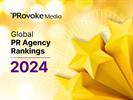Paul Holmes 02 Feb 2024 // 11:01AM GMT

There are 100 different questions reporters should be asking Boeing in the wake of yet another crisis involving the airplane manufacturer’s perpetually troubled 737 Max. Not one of those questions should involve the company’s DEI (diversity, equity and inclusion) initiatives.
When we first wrote about the problems with the 737 Max four years ago — it was number one on our list of the biggest corporate crises, in the wake of two crashes in Malaysia and Ethiopia — we talked about what crisis communications expert Rod Cartwright described as Boeing’s “cozy relationship with its key regulator, the FAA.”
A remarkably laissez-faire approach to customer safety had been revealed in March of 2019, via a blockbuster Seattle Times report, which suggested that the FAA functioned more like a business partner than a regulator. According to the report, FAA leadership “pushed the agency’s safety engineers to delegate safety assessments to Boeing itself, and to speedily approve the resulting analysis.”
A little more than a year later, The New Yorker followed up with another robust journalistic exercise, under the headline “How Boeing and the F.A.A. Created the 737 MAX Catastrophe.” In it, staff writer John Cassidy wrote: “With the connivance of the Federal Aviation Administration, Boeing developed, built, and delivered hundreds of passenger jets that were a potential danger to anyone who stepped onto them.”
The discussion about the 737 Max was reignited last month, during which it seemed as though the most important question for passengers to ask was whether pieces of the plane would start falling off in flight (as with the Alaska Airlines door “plug”) or while the plane was still on the runway (as with a Delta flight in Atlanta).
A sensible person might at least understand the relevance of asking whether essentially allowing an aircraft manufacturer to pinkie swear that its planes are safe — as opposed to insisting that an independent agency perform actual checks — might lead to a decline in safety that passengers ought to be concerned about.
And so naturally, the bulk of the recent discussion about the Boeing Max 737… has focused on Boeing’s diversity, equity and inclusion policies.
Indeed, criticism of the company’s commitment to DEI and sustainability have been unescapable on Fox News and Fox Business. A few days after the door incident, The Big Money Show host Brian Brenberg went with the hacky “just asking questions” approach: “Boeing seemed to be particularly interested in sustainability and DEI…. Does that come at the cost of something?” Over on Fox News, Laura Ingraham had apparently received the same memo, wondering whether it was “worth asking at this point is excellence what we need in airline operation or is diversity the goal here?”
A couple of days later, Fox Business host Sean Duffy opined: “This is a dangerous business when you’re focused on DEI and maybe less focused on engineering and safety.”
It wasn’t long before the focus shifted from airplane manufacturing to the airlines themselves. That shifted the conversation neatly from an area of genuine concern — regulatory capture — to an area in which the concerns were almost entirely imagined: there have been two fatalities (not two fatal crashes, but two dead people total) since 2010.
In other words, not only is the link between DEI and a crisis in airline safety totally imaginary, the crisis in airline safety is totally, entirely, wholly imaginary. Such is the post-truth, post-reason, post-fact political climate in America today.
Needless to say, Twitter/X chief troll Elon Musk was in the forefront of the collective stupidity: “Do you want to fly in an airplane where they prioritized DEI hiring over your safety? That is actually happening.” (Obviously, there is zero evidence that anything of the kind was “actually happening.” And you should feel free to compare the safety record of the airline industry to the safety record of Tesla, which has the highest accident rate of any automaker in America.)
Some conservatives were more explicit in their complaints. “I’m sorry,” co-founder of far-right pressure group Turning Point USA Charlie Kirk said on his show. “If I see a Black pilot, I’m going to be like, ‘Boy, I hope he’s qualified.’” (Is that more reasonable than me wondering whether my white pilot is only in the cockpit because white privilege is still the most pervasive affirmative action program in America?)
And on its face, the charge is perplexing. There’s no attempt in any of these segments or stories to explain how a company’s commitment to expanding the talent pool from which it recruits engineers (or, in the case of airlines, pilots). It is simply taken as given that Black or female candidates in these professions must be inferior to their white, male counterparts — a notion at least partially refuted by the fact that the pilot who landed the door-less Alaska flight was a woman.
Still, as Vox points out in its analysis of the campaign against DEI: “Underneath the attack on DEI are racist, sexist, and anti-gay ideas that women, people of color, and those in the LGBTQ+ community do not have the qualifications, skills, or intelligence to participate in society through jobs, education, leadership, and more.”
But the speciousness and barely disguised racism of the anti-diversity argument notwithstanding, there are suggestions that companies are already backing away from DEI initiatives in the wake of a Supreme Court decision banning affirmative action on college campuses. There’s plenty of reason to believe that the commitment to providing more equal opportunities was never more than skin deep anyway — Boeing’s own latest diversity data suggests that the company is still some way short of its stated DEI goals.
“In the DEI space, there’s a myth of progress,” Lily Zheng, a DEI consultant, told The Washington Post, adding that the resistance facing corporate programs today is a “step-for-step echo of the reverse racism and anti-affirmative-action attacks that were very successful back in the 60s and 70s.”
The idea that companies adopted diversity, equity and inclusion policies because of some commitment to “woke” ideology is absurd. Most CEOs are no more committed to “wokeness” than they are to serving a particular flavor of Snapple in the office vending machine.
They invested in DEI firstly because it makes sense for companies to draw talent from the broader population rather than a narrow slice; secondly, to make sure than diverse talent did not suffer racism and bias in the workplace (an issue with potential legal implications); and thirdly because a significant number of stakeholders — and consumers in particular — care about basic fairness and are willing to punish companies that continue to discriminate.
At the same time, it should be clear that all decisions about issues like sustainability, social responsibility, and equality involve a degree of cost-benefit analysis. Anti-diversity forces understand this too, and so over the past 12 months they have been working to increase the cost, using everything from vitriolic social media to the threats of physical violence that persuaded some organizations to mute their support of Pride and other LGBTQ initiatives last year.
Obviously, public relations professionals need to be aware of the ways in which the campaign against DEI is impacting broader public opinion. It is possible that the onslaught of empty rhetoric will persuade ordinary people that providing equal opportunity to diverse populations (not that DEI on its own provides anything like equal opportunity) is somehow wrong.
Even if that happens, companies should make any decision on the basis of the same facts that led them to make DEI promises in the first place: are there business benefits to recruiting from a broader talent pool; does it make sense to create a welcoming workplace that treats everyone fairly; do diverse consumers matter?
But for now, public relations professionals need to do a better job of refuting the evidence-free claims that are being made about DEI. They need to do a better job of explaining what their DEI policies are designed to accomplish, and to be absolutely honest about what they have actually accomplished — and how far most organizations still have to go before they are genuinely diverse, equitable, and inclusive.



































.jpg)






























